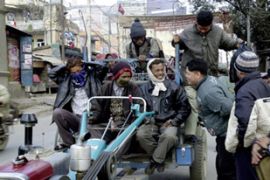Nepal police fire on protesters
Violence escalates as opponents of Maoists protest against the new interim government.

An earlier curfew imposed over the weekend was lifted on Monday morning, but shortly afterwards protesters angry at the killing of a high school student last week began to attack government buildings, Chiranjivi Adhikari, a local government administrator, said.
The curfew was then re-imposed, he said.
It was unclear if anyone was killed or injured in the violence in Lahan, about 250km southeast of Kathmandu, the capital, a local government official, said.
The police said that he clashes had injured a policeman.
However, witnesses said several protesters were hurt in the town, the focus of protests by ethnic groups opposed to the peace deal.
“First we fired in the air, even then the crowd remained uncontrolled,” a senior police officer said.
“We had to open fire at the protesters after they tried to storm the police post.”
The last few days has seen the worst violence in Nepal since the Maoists joined parliament after signing a peace deal that ended an insurgency against the monarchy.
Emergency meeting
Girija Prasad Koirala, Nepal‘s prime minister, has met leaders of the seven political parties in the ruling alliance and the Maoists.
An official investigation and measures to stop the violence were ordered.
Monday’s demonstration at Lahan was to protest the killing of a high school student on Friday when the Madhesi and the Maoists clashed.
The Madhesi who imposed a general strike fought with supporters of the Maoists who were opposed to it, leading to gunfire that reportedly killed the male student.
Poverty-stricken
The Madhesi Peoples Rights Forum, which has organised the anti-government protests, says the peace deal offers little for people living in the southern plains of the Terai, which is an impoverished region in Nepal.
The Madhesi region, also known as the Terai, is a narrow, fertile strip of southern Nepal. It holds about half the country’s population and many people have closer cultural links to nearby India than Nepal‘s highlands.
They want more jobs and funds from the central government.
“The concerns of the people living in the Terai should be adequately addressed in the interim constitution,” a Nepalese defence analyst said.
“Otherwise there is a risk of a serious conflict between the people from the hills and the plains.”